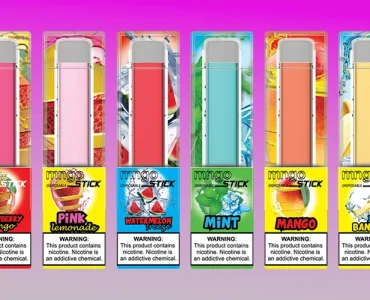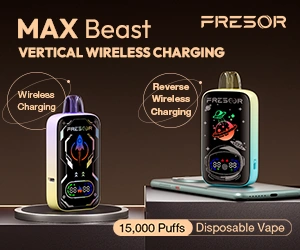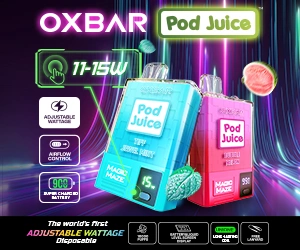The U.K. government has recently announced that it is going ahead with plans to join a small but growing group of countries banning or planning to ban disposable vapes. The new law is yet to be voted on in Parliament, but it has majority support and is likely to be approved and come into force by the end of 2025.
The proposed ban is part of a wider strategy by the British government to create a smoke-free generation and includes legislation that will make it impossible for someone who is 15 now to ever legally buy tobacco products. This will be achieved by raising the legal age for buying cigarettes or tobacco by one year, every year.
Yet despite the ambitious aims of these new laws, only disposable vapes, nicotine pouches, and potentially some e-liquid flavors, are being banned outright. The alternative route of preventing smoking by banning tobacco instead of banning something far less harmful that “might” lead to smoking was not mentioned in the public consultation on the subject.
The problem of youth vaping certainly appears to be a growing problem in many countries around the world, but we have to wonder whether banning a potentially helpful product is the best way to prevent a minority from abusing it. Could these bans even have the potential to do more harm than good?
Where Are Disposable Vapes Banned?
Australia, France, Germany, and New Zealand have all announced or implemented a ban on disposables. All appear to be motivated by the supposed new “biggest threat to public health” that is youth vaping. Some kids also drink underage, spend too long indoors playing video games, or eat more fast food than is healthy. Where are the bans on alcohol, game consoles, and burgers?
Whether the United States will also follow suit and ban disposables outright is, as yet, unknown. Some states have independently imposed bans, but it is by no means the same across the nation. However, the current requirements imposed by the FDA for a successful Pre-Market Tobacco Application (PMTA) are almost impossible for any vape device to meet.
The U.S. government might not have said they are banning disposables, but that is, essentially, what has already happened. To date, just 23 disposable or refillable vape devices have been granted marketing approval (out of perhaps a couple million applications) since vaping products were lumped together with tobacco products following the Deeming Rule amendment to the Tobacco Control Act.
Vape Bans – Health, Environment, or Politics?
The disposable bans or restrictions we have seen so far are all, at least primarily, driven by concerns about youth vaping and the appeal the often sweet or fruity vapes have for children. But while even the most ardent vaping supporters would likely agree that preventing children from vaping is a good idea, using that as a reason to ban something also used by millions of adults seems cynical.
It’s about the health of our youth, they say, and the concern that vaping leads to smoking. Yet vaping has been growing in popularity for years, and levels of youth smoking in most countries are as low as they have ever been. It’s true that the number of children who vape has increased significantly in recent years, but will a ban simply lead to an increase in underage smoking? And will it lead to more adults smoking too?
A recent report by researchers at University College London, published just a week before the British ban was announced, argues quite strongly that a ban on disposables could adversely affect 2.6 million adults who already use those devices or smokers who would benefit from access to an easy (and safer) tobacco alternative.
Senior author of the study, Professor Jamie Brown (UCL Institute of Epidemiology & Health Care,) is quoted as saying:
“There is a need for action to reduce disposable vaping among young people who have never smoked. However, trade-offs need to be carefully considered. A ban may discourage use of e-cigarettes among people trying to quit smoking and may induce relapse among those who have already used disposables to quit. Cigarettes are far more harmful to our health and are not currently banned and a ban on disposable e-cigarettes may signal to large numbers of people that these products are worse for our health or that their harm is comparable to that caused by smoking tobacco. I favour a range of alternative policies, in the first instance, allied with rapid evaluation to judge whether these are sufficient to achieve reductions in youth vaping.”
These bans, particularly in the U.K., feel more politically motivated than purely by public health concerns. Older generations, often considered more likely to vote in elections, are probably not among the average disposable vape demographic and could be more worried about kids vaping in the street or the amount of unsightly litter being created. Is a ban simply pandering to those voters, a seemingly decisive public health move that is actually rooted more in fear of the unknown than in scientific fact?
The environmental impact caused by disposables has also featured in the rationale of several countries for banning them. This reason, often added as a side note to the worries about youth vaping, should be a genuine concern for any right-minded person. In the United Kingdom alone, it is estimated that 5 million disposable vapes are thrown away each week.
That’s 260 million lithium batteries going (mostly) into landfill sites, every year. That lithium is wasted as it can never be recovered for recycling.
Are There Better Alternatives to Banning Disposables?
Many more reasonable steps could be taken before moving to the point of banning disposable vapes. Simply tightening regulations on packaging, flavors, or advertising of vapes would be easier, faster, and potentially cheaper than invoking a ban.
Prohibit branding likely to appeal to children and stop stores from openly displaying disposable vapes. Plain packaging and health warnings are mandated for cigarettes and tobacco in many countries, so why not for vapes if such a step is deemed likely to reduce the appeal?
Increasing the tax on disposables to make them comparable in price to the cheapest reusable vapes would also instantly render them less appealing to young people, and have the added benefit of encouraging adult vapers to switch to a more environmentally-friendly vape device. It would also raise additional tax revenue, which could be used to offset the billions spent on treating the effects of smoking tobacco.
A complete ban should surely be a final step, something to consider when all other regulatory measures have failed. Banning disposables smacks of a panicked response to a situation that could have been prevented or minimized by faster, more moderate actions by those in power.
Unintended Consequences of Banning Disposables
Perhaps one of the most worrying unintended consequences of banning disposables and not banning tobacco is the message it sends. It could set back the progress made toward reducing smoking by signaling that vaping is more dangerous than smoking. Why else would it be banned when smoking is still allowed?
Banning products that are widely used and popular with the general public will almost inevitably feed the black market. An example of this type of consequence has already been seen when the U.K. implemented TPD regulations to control the capacity and strength of disposables (and other vape products).
The importation of illegal vapes increased and in 2023, 4.5 million vapes were seized by the UK Border Force between January and October, and most of these were classed as illegal because they contained up to 50mg/ml liquids at quantities capable of providing several thousand puffs.
In the U.S., $18 million worth of illegal vapes were seized by the FDA and Customs & Border Protection in three days from a single airport. Banning (or effectively banning them, as in the U.S.,) disposables won’t prevent illegal imports, it will only serve to increase them by making the black market more lucrative and attractive to criminals.
Take away the legal route to import disposable vapes, and you also remove the need to adhere to any quality checks and controls. Banning disposable vapes could make vaping much more dangerous as there will be no control over what is inside them. Tech-savvy kids who will find it easy to order banned vapes online will have even less idea of what they are inhaling than they do today.
A complete ban is also likely to be expensive to enforce. More money will be needed to support enforcement agencies who try to prevent illegal vapes from entering the country or those who visit stores to check for the sale of illegal vapes. As the black market grows, so too will the cost of policing it.
The Problem With Bans: The Australian Example
Australia and its attempts to stop youth vaping with a ban could be an example of exactly how such measures can go badly wrong or, at the very least, fail in their objective. In 2021, Australia introduced a new law that made it illegal for anyone to buy a vape (disposable or otherwise) without a prescription from a medical professional.
The black market flourished, and even two years after the effective ban came into force, vape shops selling all the well-known disposable brands could still be found in almost every town and city. Some Australians reported that they had no idea the law had even changed and could walk into any number of stores and buy a vape over the counter without any questions. Indeed, it is thought that more than 90% of Australia’s vapers now get their vapes from illegal sources.
While this effective ban was in place, the number of vapers in Australia grew by 1.7 million people, an increase of 349% in five years. In 2022 alone, more than a year after disposables were supposedly illegal unless prescribed to adults, 12% of 12 to 15-year-olds and 22% of 16 to 17-year-olds reported using one in the previous month.
Without evidence for a corresponding surge in doctor visits for adults and because teenagers are unable to get a prescription at all, these figures suggest a huge and active black market that even Australia’s new 2024 ban on disposable imports will struggle to curtail. And that is despite the hundreds of millions of extra AUS$ being promised to the agencies that control the borders.
The Bottom Line
Most people would agree that preventing children and teenagers from being able to get easy access to disposable vapes is an important step to take. But an outright ban, as opposed to better regulation, seems like a step in the wrong direction when it is very likely to also adversely and unfairly affect responsible adult vapers.
Banning less harmful vaping because it may lead to more harmful smoking, rather than just banning tobacco, seems to make little sense if public health is the core concern.










Add comment